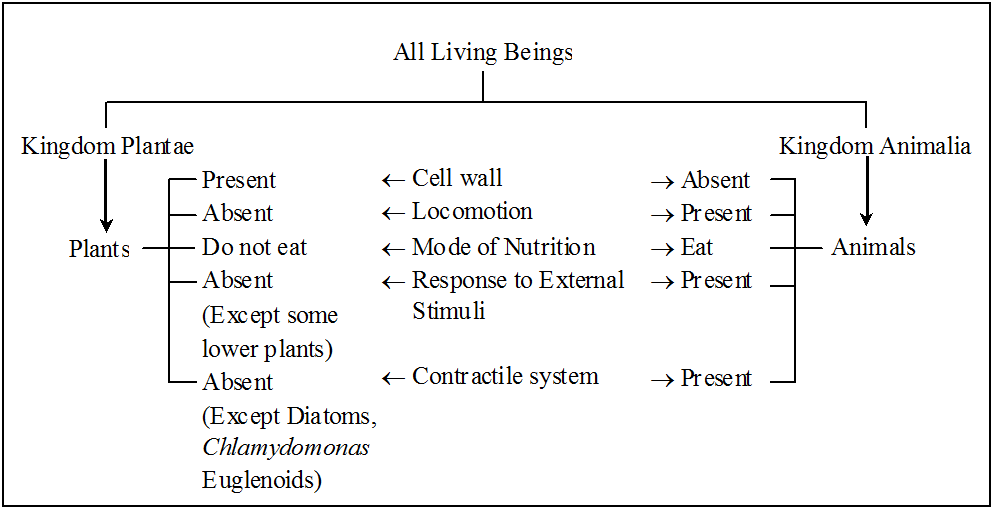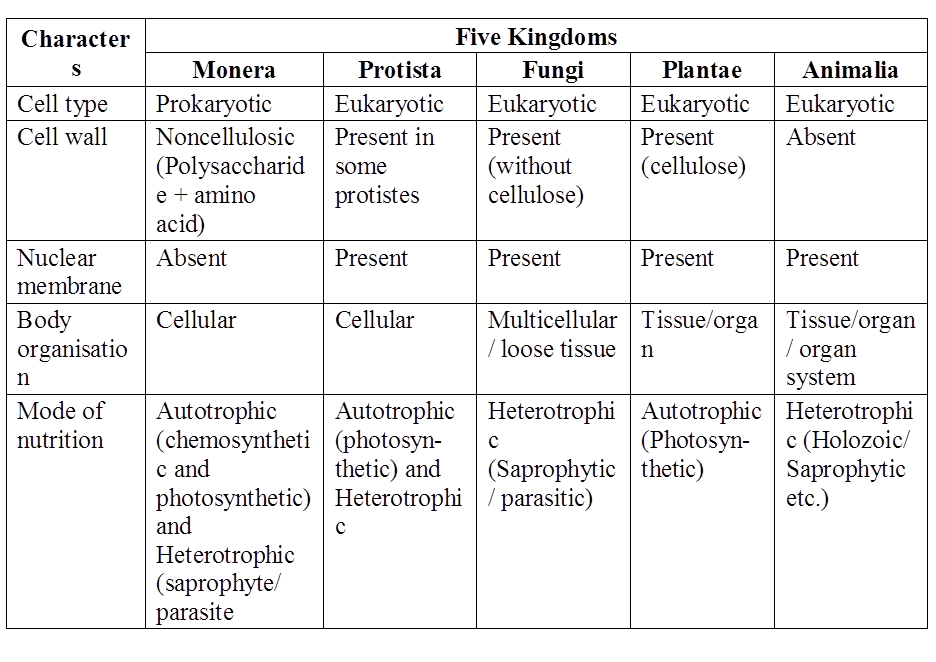- Books Name
- ACME SMART COACHING Biology Book
- Publication
- ACME SMART PUBLICATION
- Course
- CBSE Class 11
- Subject
- Biology
KINGDOM SYSTEMS OF CLASSIFICATION
(1) Two Kingdom Classification: It was given by Linnaeus. Traditionally all the organisms of the world were divided into two kingdoms -the animal kingdom (Animalia) and the plant kingdom (Plantae). The major criterion of classification was the presence or absence of cell wall. Other criterias were locomotion, mode of nutrition, response to external stimuli etc
Concept Builder

Shortcomings of two-kingdom system of classification:
This system did not distinguish between the eukaryotes and prokaryotes, unicelled and multicelled organisms, photosynthetic and non-photosynthetic organisms.
There are few organisms like Chlamydomonas, Euglena and the slime moulds which have been claimed by both zoologists and botanists (organisms which share characteristics of both animals and plants).
Since there are certain organisms that do not fall naturally into either plant or animal kingdom, it was proposed that a new kingdom is to be established to accommodate such organisms.
(2) Three Kingdom Classification:
Haeckel, a German zoologist (1866), suggested that a third kingdom Protista, be created to include all unicellular microorganisms.
This includes a wide variety of unicellular, mostly aquatic eukaryotes like -Fungi, Protozoa, Algae, Bacteria and Slime moulds.
Thus, he proposed three kingdoms, namely -Plantae, Protista and Animalia.
(3) Four Kingdom Classification:
Copeland (1956) gave four kingdom of classification and included Monera as fourth kingdom.
Copeland originally called it as kingdom 'Mychota'.
It was called 'Monera' by Daugherty and Allen.
Kingdom Monera includes all the prokaryotic organisms i.e., eubacteria (including cyanobacteria, formerly known as blue-green algae) and archaebacteria.
The actinomycetes (filamentous bacteria) are also included in this kingdom.
(4) Five Kingdom Classification:
According to five-kingdom concept proposed by R.H. Whittaker.
Whittaker (1969), the organisms are divided into five kingdoms namely Monera, Protista, Fungi, Plantae, Animalia, on the basis of the following criteria
(a) Complexity of cell structure: prokaryotic vs eukaryotic organisation of cells.
(b) Complexity of body organisation: unicellularity vs multicellularity; simple multicellular forms to complex multicellular forms.
(c) Mode of nutrition: Autotrophic vs heterotrophic (parasitic or saprobic or ingestive organisms). It was the major criteria of this classification system.
(d) Reproduction.
(e) Phylogenetic or evolutionary interrelations
Table 1 : Comparative account of different characteristics of the Five Kingdoms

(5) Six Kingdom Classification :
Carl Woese proposed six kingdom classification.
These six kingdoms are Archaebacteria, Eubacteria, Protista, Fungi, Plantae and Animalia.
He separated the archaebacteria from eubacteria on the basis of some major differences such as the absence of peptidoglycan in the cell walls of the former and the occurrence of branched chain lipids (a monolayer instead of a phospholipid bilayer) in the membrane.
Based on the sequence of 16S ribosomal RNA genes, Woese found that the six kingdoms naturally cluster into three main categories.
He called these categories as domains of life.
These domains are Bacteria, Archae and Eukarya and are believed to have originated from common ancestor called progenote.
Three Domains of life
Based on the sequence of 16 S ribosomal RNA genes, woese found that the six kingdoms naturally cluster into three domains.
These domains are Archae, Bacteria and Eukarya, and are believed to be originated from common ancestor called Progenate. Domain is a category higher than kingdom.

Chapter 2
Biological Classification
Biological classification is the practice of categorizing living and extinct organisms into groups based on shared traits. Classifying organisms is necessary because it allows us to better understand biodiversity. It aids in the identification of living entities as well as the comprehension of their diversity. Classification aids in our understanding of different types of plants and animals and their characteristics, similarities, and differences. It allows us to see how complex organisms develop from simpler organisms. Different categories are used to understand and research the characteristics, similarities, and differences among various living species. Classification is the tool that allows us to manage a wide range of living organisms. Understanding the inter-relationships between different groups of organisms is critical. Other biological sciences are built on the foundation of classification.
Kingdom Systems of Classification:
Aristotle was the first to attempt to classify things on a more scientific basis. He classified plants into trees, shrubs, and herbs based on simple physical characteristics. He also separated the animals into two groups: those with red blood and those without. A Two Kingdom system of classification was devised during Linnaeus's time, with Plantae and Animalia kingdoms encompassing all plants and animals, respectively. Eukaryotes and prokaryotes, unicellular and multicellular organisms, photosynthetic (green algae), and non-photosynthetic (fungi) species were all lumped together in this system. Plant and animal classifications were simple to implement and understand, but a huge number of creatures did not fit into either group. As a result, the long-used two-kingdom classification was determined to be inadequate. Aside from gross appearance, there was a need to include other characteristics such as cell structure, wall nature, manner of nourishment, habitat, reproduction strategies, evolutionary linkages, and so on. As a result, classification systems for living organisms have experienced several alterations over time. Though the plant and animal kingdoms have remained consistent throughout all systems, the understanding of which groups/organisms should be included inside these kingdoms has evolved; the number and character of additional kingdoms have also been interpreted differently over time by different scientists.
A Five Kingdom Classification was proposed by R.H. Whittaker in 1969. Monera, Protista, Fungi, Plantae, and Animalia were the kingdoms he defined. Cell structure, body arrangement, manner of nourishment, reproduction, and phylogenetic links are among his key classification criteria. A three-domain approach has also been proposed, which divides Kingdom Monera into two domains and leaves the remaining eukaryotic kingdoms in the third domain, resulting in a six-kingdom categorization.
Let's take a look at this five-kingdom classification to see what concerns and considerations affected the system. Plants included bacteria, blue-green algae, fungi, mosses, ferns, gymnosperms, and angiosperms in previous classification systems. The fact that all of the species in this kingdom had a cell wall in their cells served as a unifying characteristic. This grouped people who had a lot of things in common but also had a lot of things in common. It brought together prokaryotic bacteria and blue-green algae (cyanobacteria), as well as other eukaryotic species. It also combined unicellular and multicellular species together, such as Chlamydomonas and Spirogyra being categorized together under algae.The classification did not distinguish between the heterotrophic fungus and the autotrophic green plants, albeit they did have a distinct difference in the composition of their cell walls, with the fungi having chitin and the green plants having a cellulose cell wall. When these qualities were taken into account, the fungi were given their own kingdom: Kingdom Fungi. Kingdom Monera was created to unite all prokaryotic species together, while Kingdom Protista was created to group all unicellular eukaryotic organisms together. Chlamydomonasand Chlorella (both of which have cell walls and were previously put in Algae within Plants) have been combined with Paramoecium and Amoeba in the kingdom Protista (which were earlier placed in the animal kingdom which lack cell walls). It has brought together organisms that were previously classified into various kingdoms.

 ACME SMART PUBLICATION
ACME SMART PUBLICATION
